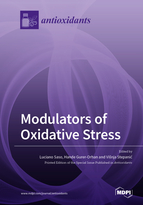Modulators of Oxidative Stress: Chemical and Pharmacological Aspects
A special issue of Antioxidants (ISSN 2076-3921). This special issue belongs to the section "Health Outcomes of Antioxidants and Oxidative Stress".
Deadline for manuscript submissions: closed (31 January 2020) | Viewed by 98659
Special Issue Editors
Interests: pharmacology; therapeutic modulators of oxidative stress
Special Issues, Collections and Topics in MDPI journals
Interests: endocrine and/or oxidative stress-modulating compounds, mainly melatonin analogues, as therapeutic agents in hormone-related diseases
Interests: redox active compounds; anticancer treatment; chemoprevention; natural products and derivatives
Special Issues, Collections and Topics in MDPI journals
Special Issue Information
Dear Collegaues,
Reactive oxygen (ROS), nitrogen (RNS), and sulfur (RSS) species are implicated in the pathogenesis of a variety of pathological conditions, including chronic infections, inflammatory disorders, cardiovascular diseases, neurodegenerative diseases, and cancer. Unfortunately, antioxidant therapies did not prove to be effective in most of the clinical studies for different reasons that have been reviewed elsewhere [1,2]. However, modulation of oxidative stress, particularly through regulation of gene transcription through, e.g., activation or inhibition of Nrf2, is considered to be an important strategy for the development of new drugs for some of these pathologies, such as cardiovascular and neoplastic diseases that are resistant to other treatments [3–5]. The main aim of this Special Issue is to present studies that address different chemical, biological, physiological, pharmaceutical, and pharmacological aspects of the modulation of oxidative stress. Potential topics include, but are not limited to:
- synthesis and derivatization of oxidative stress modulators with potential pharmacological applications, and the optimization of their antioxidant properties and bioavailability;
- non-radical scavenging mechanisms of action of oxidative stress modulators, particularly the Keap1/Nrf2/ARE signaling pathway;
- pharmacokinetics, metabolic pathways, and antioxidant activity of metabolites
- in vitro and in vivo studies on the pharmacological activity of oxidative stress modulators;
- epidemiological and clinical studies on the efficacy of redox therapies; and
- relevant biological markers for assessing in vivo antioxidant/pro-oxidant activity and its correlation with clinical efficacy.
Prof. Hande Gurer-Orhan
Dr. Višnja Stepanić
Guest Editors
Selected references
- Firuzi, O.; Miri, R.; Tavakkoli, M.; Saso, L. Antioxidant therapy: current status and future prospects. Med. Chem. 2011, 18, 3871–3888.
- Saso, L.; Firuzi, O. Pharmacological applications of antioxidants: lights and shadows. Drug Targets 2014, 15, 1177–1199.
- Panieri, E.; Saso, L. Potential Applications of NRF2 Inhibitors in Cancer Therapy. Med. Cell. Longev. 2019, 2019, 8592348.
- Telkoparan-Akillilar, P.; Suzen, S.; Saso, L. Pharmacological Applications of Nrf2 Inhibitors as Potential Antineoplastic Drugs. J. Mol. Sci. 2019, 20, 2025.
- Sova, M.; Saso, L. Design and development of Nrf2 modulators for cancer chemoprevention and therapy: a review. Drug Des. Devel Ther. 2018, 12, 3181–3197.
Manuscript Submission Information
Manuscripts should be submitted online at www.mdpi.com by registering and logging in to this website. Once you are registered, click here to go to the submission form. Manuscripts can be submitted until the deadline. All submissions that pass pre-check are peer-reviewed. Accepted papers will be published continuously in the journal (as soon as accepted) and will be listed together on the special issue website. Research articles, review articles as well as short communications are invited. For planned papers, a title and short abstract (about 100 words) can be sent to the Editorial Office for announcement on this website.
Submitted manuscripts should not have been published previously, nor be under consideration for publication elsewhere (except conference proceedings papers). All manuscripts are thoroughly refereed through a single-blind peer-review process. A guide for authors and other relevant information for submission of manuscripts is available on the Instructions for Authors page. Antioxidants is an international peer-reviewed open access monthly journal published by MDPI.
Please visit the Instructions for Authors page before submitting a manuscript. The Article Processing Charge (APC) for publication in this open access journal is 2900 CHF (Swiss Francs). Submitted papers should be well formatted and use good English. Authors may use MDPI's English editing service prior to publication or during author revisions.
Keywords
- antioxidants
- modulation of oxidative stress
- gene transcription modulation
- Nrf2








